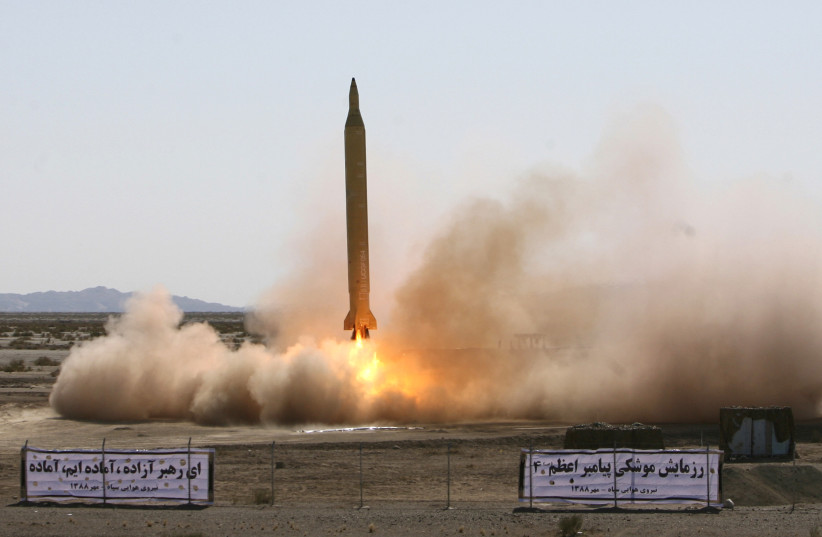Why are Iran’s missiles a growing threat? – analysis
An announcement by Iran that it tested a new long-range ballistic missile on Friday reveals the growing threat that Iran’s missiles pose to the region.
To understand the threat, we need to understand Iran’s complex missile program. There is a bit of complexity here because Iran keeps coming up with new names for its missiles, even if they are part of an existing group of missiles. It also has a variety of types of missiles, in terms of range and fuel used and even which part of Iran’s defense and space industries produces the systems.
Iran has been developing missiles since the 1980s, and today the country continues to increase the range and precision of its missiles. It also continues to work with both liquid and solid fueled missiles. Iran also continues to work on missiles that can launch satellites and it is working on cruise missiles and precision guided munitions. What this essentially means is that Iran has a plethora of options when it comes to fielding weapons that can threaten Israel, the US and also countries in the region and in Europe and Asia.
Iran’s missile and rocket program has origins not only in the 1980s but also in copying, reverse engineering and modelling new missiles on those that Iran was able to acquire from what were once Soviet, Chinese or North Korean models. For instance, the Iranian Shahab class of missiles are likely derived from the North Korean Nodong-A, and the Iranian Tondar short-range missile is modeled on a Chinese missile.
What are the abilities of Iran’s missiles?
Iran’s missiles are often in the spotlight and there is a lot of knowledge about them. The Center for Strategic and International Studies based in Washington has a report on Iran’s program that lists most of Iran’s major missiles. Their list includes the medium-range ballistic missiles Emad, Ghadr-1 (Shabab 3 variants), Khorramshahr, Sejjil and Shahab 3 as well as short-range ballistic missiles Zolfaghar, TOndar-69, Shahab-2, Shahab-1, Qiam-1, Fateh-110 and Fateh-313. Satellite launch vehicles include the Safir and Simorgh.
 A Ghadr 1 class Shahab 3 long range missile is prepared for launch during a test from an unknown location in central Iran (credit: REUTERS)
A Ghadr 1 class Shahab 3 long range missile is prepared for launch during a test from an unknown location in central Iran (credit: REUTERS)To understand the ranges here, the Khorramshahr, which is the class of missile Iran recently tested, may have a range beyond 2,000 k.m. while the Shahab-3 variants Emad and Ghadr both have ranges between 1,700 and 1,950 k.m.. Shahab 3 itself has a range of around 1,300 k.m.. Similarly to Khorramshahr, the Sejjil may have a range of 2,000 k.m.. Iran also makes the Soumar cruise missile which it claims can reach up to 3,000 k.m.. In addition, the SLVs are measured in how high they can place a satellite and most have a range up to 500 k.m.. Many of the missiles that have the longest range are still considered in development, such as the Simorgh, Emad, Ghadr and Khorramshahr.
The missiles can also be divided into different types of fuels used in their propulsion. For instance, the Shahab missiles, Emad, Ghadr, KhorramShahr and Qiam are all liquid fueled. The Sejjil, Fateh, Dezful, Raad, Zulfiqar, and Tondar are solid fueled. There is no range distinction on these fuels, both solid and liquid are used for short- and medium-range missiles. Solid fueled missiles may have advantages in terms of speed of deployment, so that Iran could use its missiles quickly even if under some kind of attack.
The Foundation for Defense of Democracies put out an extensive look at Iran’s missiles in February 2023. It notes that since 2015, when Iran agreed to the Iran Deal, it has launched some 228 ballistic missiles.
“Iran, despite limitations on their missile testing laid down in the Iranian nuclear deal, has continued to test ballistic missile technology. The deal prohibits Iran from testing any missile designed to carry a nuclear warhead for a period of eight years but not from testing other missiles. Iran has pushed this framework on multiple occasions, most recently on June 18th, 2017, when Iran tested the Khorramshahr missile. The specifications of the missile are unknown, and therefore it is as yet unclear if the test violated this agreement,” the article notes.
An article at the Missile Defense Advocacy Alliance further argues that “Iran’s missile strikes against targets in Syria and Iraq (June 18, 2017, and September 08, 2018, respectively) suggest a pattern to Iran’s missile attacks. In both strikes, an unmanned aerial vehicle (UAV) was sent over the target area to conduct a battle damage assessment, one liquid-fueled ballistic missile and around six solid-propellant ballistic missiles. Current conflicts in the Middle East have served as proving grounds for new missiles and practice for Iranian missile forces.”
Iran’s missile are thus a multi-layered threat. First of all, Iran continues to develop its missile program through a variety of efforts, including via the IRGC and the Iranian space program. Second, Iran continues to export the missiles to countries in the region, usually to allied proxies and militias, such as the Houthis, Hezbollah, militias in Iraq and Syria and also via transferring information to Palestinian terror groups.
Iran also seeks to build more complex missiles, either using different types of fuel or investing in cruise missiles, maneuvering munitions and also greater precision. Iran also seeks to use missiles and drones in concert in its attacks. Clearly Iran’s attempt to develop a missile that has a long range and which could include a nuclear warhead is the height of the missile threat. If Iran has a missile capable of carrying that kind of warhead, then Iran’s attempt at weaponizing its nuclear program would be even more dangerous for the world.





Comments are closed.